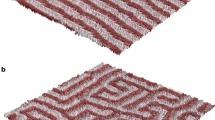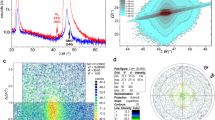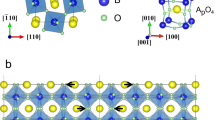Abstract
Simultaneous manipulation of multiple boundary conditions in nanoscale heterostructures offers a versatile route to stabilizing unusual structures and emergent phases. Here, we show that a stable supercrystal phase comprising a three-dimensional ordering of nanoscale domains with tailored periodicities can be engineered in PbTiO3–SrRuO3 ferroelectric–metal superlattices. A combination of laboratory and synchrotron X-ray diffraction, piezoresponse force microscopy, scanning transmission electron microscopy and phase-field simulations reveals a complex hierarchical domain structure that forms to minimize the elastic and electrostatic energy. Large local deformations of the ferroelectric lattice are accommodated by periodic lattice modulations of the metallic SrRuO3 layers with curvatures up to 107 m−1. Our results show that multidomain ferroelectric systems can be exploited as versatile templates to induce large curvatures in correlated materials, and present a route for engineering correlated materials with modulated structural and electronic properties that can be controlled using electric fields.
This is a preview of subscription content, access via your institution
Access options
Access Nature and 54 other Nature Portfolio journals
Get Nature+, our best-value online-access subscription
$29.99 / 30 days
cancel any time
Subscribe to this journal
Receive 12 print issues and online access
$259.00 per year
only $21.58 per issue
Buy this article
- Purchase on Springer Link
- Instant access to full article PDF
Prices may be subject to local taxes which are calculated during checkout






Similar content being viewed by others
Data availability
The STEM dataset and analysis used for calculating the curvature of the SrRuO3 layers can be found at temul-toolkit.readthedocs.io/en/latest/PTO_supercrystal_hadjimichael.html. Other datasets supporting the findings of this study are available from the corresponding authors upon reasonable request.
References
Schlom, D. G. et al. Strain tuning of ferroelectric thin films. Annu. Rev. Mater. Res. 37, 589–626 (2007).
Roytburd, A. L., Ouyang, J. & Artemev, A. Polydomain structures in ferroelectric and ferroelastic epitaxial films. J. Phys. Condens. Matter 29, 163001 (2017).
Catalan, G., Seidel, J., Ramesh, R. & Scott, J. F. Domain wall nanoelectronics. Rev. Mod. Phys. 84, 119–156 (2012).
Tang, Y. L. et al. Observation of a periodic array of flux-closure quadrants in strained ferroelectric PbTiO3 films. Science 348, 547–551 (2015).
Yadav, A. K. et al. Observation of polar vortices in oxide superlattices. Nature 530, 198–201 (2016).
Das, S. et al. Observation of room-temperature polar skyrmions. Nature 568, 368–372 (2019).
Zubko, P. et al. Negative capacitance in multidomain ferroelectric superlattices. Nature 534, 524–528 (2016).
Stoica, V. A. et al. Optical creation of a supercrystal with three-dimensional nanoscale periodicity. Nat. Mater. 18, 377–383 (2019).
Damodaran, A. R. et al. Phase coexistence and electric-field control of toroidal order in oxide superlattices. Nat. Mater. 16, 1003–1009 (2017).
Pierangeli, D. et al. Super-crystals in composite ferroelectrics. Nat. Commun. 7, 10674 (2016).
Catalan, G. et al. Flexoelectric rotation of polarization in ferroelectric thin films. Nat. Mater. 10, 963–967 (2011).
Kittel, C. Theory of the structure of ferromagnetic domains in films and small particles. Phys. Rev. 70, 965–971 (1946).
Schilling, A. et al. Scaling of domain periodicity with thickness measured in BaTiO3 single crystal lamellae and comparison with other ferroics. Phys. Rev. B 74, 024115 (2006).
Nesterov, O. et al. Thickness scaling of ferroelastic domains in PbTiO3 films on DyScO3. Appl. Phys. Lett. 103, 142901 (2013).
Pertsev, N. A. & Zembilgotov, A. G. Energetics and geometry of 90-degrees domain-structures in epitaxial ferroelectric and ferroelastic films. J. Appl. Phys. 78, 6170–6180 (1995).
Morioka, H. et al. Suppressed polar distortion with enhanced Curie temperature in in-plane 90 degrees-domain structure of a-axis oriented PbTiO3 Film. Appl. Phys. Lett. 106, 042905 (2015).
May, S. J. et al. Magnetically asymmetric interfaces in a LaMnO3/SrMnO3 superlattice due to structural asymmetries. Phys. Rev. B 77, 174409 (2008).
Koster, G. et al. Structure, physical properties, and applications of SrRuO3 thin films. Rev. Mod. Phys. 84, 253–298 (2012).
Hadjimichael, M., Li, Y., Yedra, L., Dkhil, B. & Zubko, P. Domain structure and dielectric properties of metal-ferroelectric superlattices with asymmetric interfaces. Phys. Rev. Mater. 4, 094415 (2020).
Hytch, M. J., Snoeck, E. & Kilaas, R. Quantitative measurement of displacement and strain fields from HREM micrographs. Ultramicroscopy 74, 131–146 (1998).
Liu, Y. et al. Large scale two-dimensional flux-closure domain arrays in oxide multilayers and their controlled growth. Nano Lett. 17, 7258–7266 (2017).
Li, S. et al. Periodic arrays of flux-closure domains in ferroelectric thin films with oxide electrodes. Appl. Phys. Lett. 111, 052901 (2017).
Shafer, P. et al. Emergent chirality in the electric polarization texture of titanate superlattices. Proc. Natl Acad. Sci. USA 115, 915–920 (2018).
Zubko, P., Stucki, N., Lichtensteiger, C. & Triscone, J. M. X-ray diffraction studies of 180º ferroelectric domains in PbTiO3/SrTiO3 superlattices under an applied electric field. Phys. Rev. Lett. 104, 187601 (2010).
Junquera, J. & Ghosez, P. Critical thickness for ferroelectricity in perovskite ultrathin films. Nature 422, 506–509 (2003).
Yudin, P. V. & Tagantsev, A. K. Fundamentals of flexoelectricity in solids. Nanotechnology 24, 432001 (2013).
Zubko, P., Catalan, G. & Tagantsev, A. K. Flexoelectric effect in solids. Annu. Rev. Mater. Res. 43, 387–421 (2013).
Kim, T. H. et al. Polar metals by geometric design. Nature 533, 68–72 (2016).
Ortix, C., Kiravittaya, S., Schmidt, O. G. & van den Brink, J. Curvature-induced geometric potential in strain-driven nanostructures. Phys. Rev. B. 84, 045438 (2011).
Streubel, R. et al. Magnetism in curved geometries. J. Phys. D. Appl. Phys. 49, 363001 (2016).
Leake, S. J. et al. The Nanodiffraction beamline ID01/ESRF: a microscope for imaging strain and structure. J. Synchrotron Radiat. 26, 571–584 (2019).
Chahine, G. A. et al. Advanced non-destructive in situ characterization of metals with the French Collaborating Research Group D2AM/BM02 Beamline at the European Synchrotron Radiation Facility. Metals 9, 352 (2019).
Nord, M., Vullum, P. E., MacLaren, I., Tybell, T. & Holmestad, R. Atomap: a new software tool for the automated analysis of atomic resolution images using two-dimensional Gaussian fitting. Adv. Struct. Chem. Imag. 3, 9 (2017).
Marton, P. & Hlinka, J. Simulation of domain patterns in BaTiO3. Phase Transit. 79, 467–483 (2006).
Hlinka, J. & Marton, P. Phenomenological model of a 90° domain wall in BaTiO3-type ferroelectrics. Phys. Rev. B 74, 104104 (2006).
Ondrejkovic, P., Marton, P., Stepkova, V. & Hlinka, J. in Domain Walls: From Fundamental Properties to Nanotechnology Concepts (eds Meier, D. et al.) (Oxford Univ. Press, 2020).
Everhardt, A. S. et al. Temperature-independent giant dielectric response in transitional BaTiO3 thin films. Appl. Phys. Rev. 7, 011402 (2020).
Acknowledgements
We thank V. Tileli for preliminary TEM characterization and ESRF for provision of synchrotron radiation facilities. Parts of this work were supported by the EPSRC through grant nos. EP/M007073/1 (P.Z. and M.H.) and EP/S010769/1 (P.Z., Y.L. and E.Z.), the China Scholarship Council (Y.L.), UCL-ESRF Impact scholarship (E.Z.) and the A. G. Leventis Foundation (M.H.). J.H. and P.O. acknowledge support from the Czech Science Foundation (project 19-28594X). M.C., K.M., E.N.O’C. and U.B. acknowledge financial support from Science Foundation Ireland (SFI 16/US/3344). M.C. acknowledges funding from SFI Industry Fellowship (18/IF/6282).
Author information
Authors and Affiliations
Contributions
Sample growth and laboratory diffraction measurements were carried out by M.H. and Y.L. Synchrotron experiments were carried out by M.H., E.Z., G.A.C. and S.L. The results were analysed and interpreted by M.H. and P.Z. PFM measurements were carried out by Y.L. STEM sample preparation, measurements and analysis were performed by M.C., K.M., E.N.O’C. and U.B. Phase-field simulations were performed by P.O., P.M. and J.H. M.H. and P.Z. conceived the project and drafted the manuscript with input from all authors.
Corresponding authors
Ethics declarations
Competing interests
The authors declare no competing interests.
Additional information
Peer review information Nature Materials thanks Oleg Shpyrko and the other, anonymous, reviewers for their contribution to the peer review of this work.
Publisher’s note Springer Nature remains neutral with regard to jurisdictional claims in published maps and institutional affiliations.
Supplementary information
Supplementary Information
Supplementary Figs. 1–14, Table 1 and refs. 1–4.
Supplementary Video 1
Synchrotron XRD 3D reciprocal space map.
Rights and permissions
About this article
Cite this article
Hadjimichael, M., Li, Y., Zatterin, E. et al. Metal–ferroelectric supercrystals with periodically curved metallic layers. Nat. Mater. 20, 495–502 (2021). https://doi.org/10.1038/s41563-020-00864-6
Received:
Accepted:
Published:
Issue Date:
DOI: https://doi.org/10.1038/s41563-020-00864-6
This article is cited by
-
Absence of critical thickness for polar skyrmions with breaking the Kittel’s law
Nature Communications (2023)
-
The emergence of three-dimensional chiral domain walls in polar vortices
Nature Communications (2023)
-
Electronic materials with nanoscale curved geometries
Nature Electronics (2022)
-
Ferroelectric incommensurate spin crystals
Nature (2022)
-
Giant voltage amplification from electrostatically induced incipient ferroelectric states
Nature Materials (2022)



